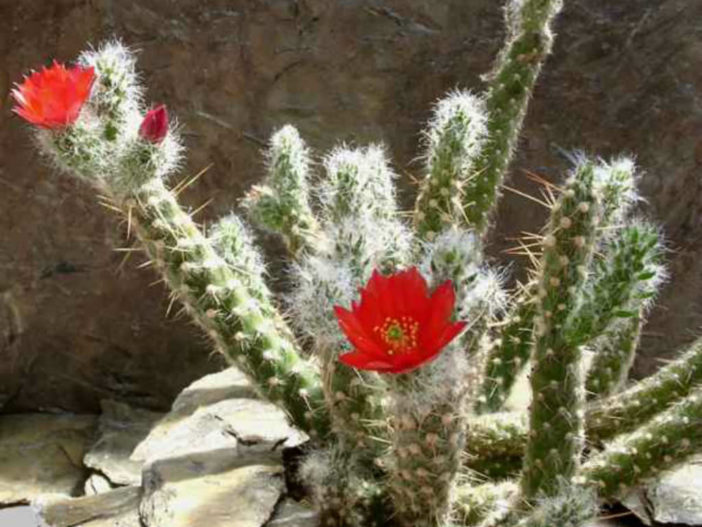Scientific Name
Austrocylindropuntia vestita (Salm-Dyck) Backeb
Common Name(s)
Old Man Opuntia, Cotton Pole, Cotton Pole Cactus, Cotton Coral, Cotton Coral Cactus
Synonym(s)
Austrocylindropuntia chuquisacana, Cylindropuntia vestita, Opuntia chuquisacana, Opuntia vestita, Pseudotephrocactus vestitus, Trichopuntia vestita, Cylindropuntia teres
Scientific Classification
Family: Cactaceae
Subfamily: Opuntioideae
Tribe: Austrocylindropuntieae
Genus: Austrocylindropuntia
Description
Austrocylindropuntia vestita is a cactus with slender cylindrical stems densely covered with long white hairs. The stems grow up to 25 inches (60 cm) tall and up to 1.2 inches (3 cm) in diameter, branched basally and near the tip. They have thin leaves and a few white, up to 0.4 inches (1 cm) long spines. Flowers are deep red or violet, up to 1.4 inches (3.5 cm) long, and up to 1.2 inches (3 cm) in diameter. They appear at the tip of the stems from late spring to early summer.

Hardiness
USDA hardiness zones 9b to 11b: from 25 °F (−3.9 °C) to 50 °F (+10 °C).
How to Grow and Care
Though the large variety of species within the Opuntia genus means different types of Prickly Pears may need slightly different care. All are desert cacti that need lots of sun, lots of light, and very little water. If you live in a hot, arid area, these plants can generally be planted outside, left alone, and enjoyed.
These cacti will grow just fine in a garden, but they can also be grown in pots. To repot, ensure the soil is dry, remove the pot and knock away the old soil. After treating any cuts with fungicide, place the cactus in a new pot and backfill it with potting soil. As with a new cutting, ensure not to water a newly repotting Prickly Pear for a brief period to avoid rotting its roots.
Opuntia can propagate either by cuttings or by seed. To propagate by cuttings, sever pads from a plant and let them dry, so the wounds heal. Then place the plants in dry soil and refrain from watering them until they begin to grow to avoid rotting them.
Learn more at How to Grow and Care for Opuntia.
Origin
This species is native to Bolivia and northern Argentina.
Links
- Back to genus Austrocylindropuntia
- Succupedia: Browse succulents by Scientific Name, Common Name, Genus, Family, USDA Hardiness Zone, Origin, or cacti by Genus
Photo Gallery
Click on a photo to see a larger version.



